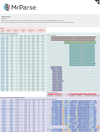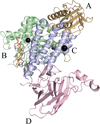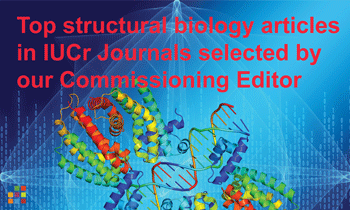issue contents
May 2022 issue

Cover illustration: A unique endoglucanase, MtGlu5 from Meiothermus taiwanensis WR-220 with a carbohydrate-binding module inserted in the middle of the catalytic domain, has been characterized structurally and functionally, providing insights into the mode of action responsible for its enhanced catalytic performance [Ye et al. (2022), Acta Cryst. D78, 633–646]. The findings reveal a way to incorporate a CBM into the catalytic domain of an existing enzyme to make a robust cellulase.
CCP-EM
Open  access
access
 access
accessA new and comprehensive resource is described that contains validation information for all cryo-EM structures that are available in the public archives, EMDB and PDB, based on recommendations from the cryo-EM community.
CCP4
Open  access
access
 access
accessMrParse is a software package designed to aid decision making in molecular replacement (MR). It performs a sequence search to find search models, not only in the PDB, as would conventionally be performed, but also in the EBI AlphaFold database, and provides a series of analyses relevant to MR such as crystal pathology detection and sequence analysis.
research papers
The Zea mays BAM7 gene encodes two transcripts. The shorter transcript, called ZmBAM7-S, forms a catalytically active, tetrameric structure with sigmoidal kinetics that is similar to Arabidopsis BAM2.
Open  access
access
 access
accessAllosteric inhibitors that bind to the middle domain (MD) or C-terminal domain (CTD) of Hsp90 have become promising drug leads for the development of effective and nontoxic chemicals in anticancer drug discovery. The structure of MDCC-labeled Hsp90α MD and CTD reported here provides the first direct visual insight into allosteric binding inhibitors of Hsp90 MD or CTD and provides a basis for the design of novel drugs for the treatment of cancer and neurodegenerative diseases.
PDB reference: Hsp90α MC domain covalently linked to MDCC, 7ry1
The crystal structure of phenylalanine hydroxylase from Bacillus cereus ATCC 14579 with three distinct domains is reported. The structural features and biochemical properties of the two novel auxiliary domains are investigated.
Open  access
access
 access
accessThe structures of four coral chromoproteins reveal conserved dimer interfaces and insights into chromophore interactions that are important for colour development.
Based on crystal structures of MalE from Salmonella enterica bound to maltopentaose, domain-swapped dimeric conformations are discussed.
The structure of the antigen-binding fragment of mouse monoclonal antibody 7H2.2 in complex with a 15-residue fragment from the metalloproteinase sperm acrosomal SLLP1 binding protein (SAS1B) has been determined at 2.75 Å resolution. The antigen is an amphipathic α-helix that corresponds to one of only two elements of secondary structure that are predicted to be ordered within the C-terminal region of SAS1B, which provides a basis for the targeted use of SAS1B.
PDB reference: 7H2.2 Fab in complex with SAS1B C-terminal region, 7st8
Open  access
access
 access
accessA unique endoglucanase with a carbohydrate-binding module inserted in the middle of the catalytic domain has been characterized structurally and functionally, providing insights into the mode of action responsible for its enhanced catalytic performance.
Open  access
access
 access
accessThe sialic acid acetylesterase from P. vulgatus was produced heterologously in Escherichia coli, purified and crystallized in two different crystal forms, from which structures at 1.44 and 2.06 Å resolution were obtained.
Open  access
access
 access
accessThe crystal structure of a GH115 α-glucuronidase obtained in complex with xylohexaose and Ca2+ reveals that the two molecules constituting the homodimer cooperatively bind the substrate and that a divalent ion is involved in formation of the Michaelis–Menten complex and is likely to contribute to the formation of a protein wire that is essential for catalysis.
Open  access
access
 access
accessThe first structures of a choline-O-sulfatase bound to different ligands are reported.


 journal menu
journal menu






























